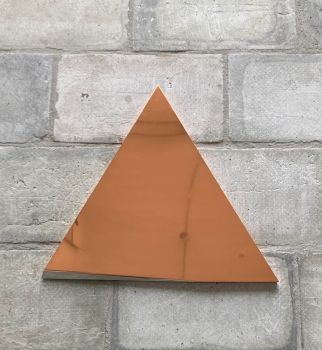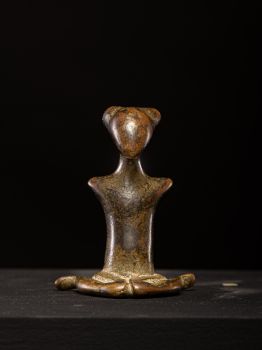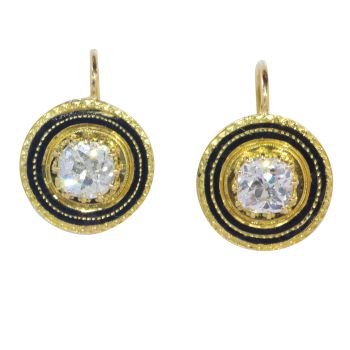Chinese carnelian agate vase or brush washer, 18th/19th century, Qing dynasty 1720 - 1820
Artista Desconhecido
ÁgataCarnelianGemstone
7.80 ⨯ 9.50 ⨯ 5.50 cm
ConditionMinor damages
Preço em pedido
Menken Works of Art
- Sobre arteA fine Chinese red carnelian agate ‘tree trunk’ vase or washer.
Qing dynasty, 18th-19th century.
Cleverly hollowed out and carved in relief as a section of a tree trunk, the exterior with gnarled leafy tree branches issuing peaches, flanked by two lingzhi and a bat flying in upward motion.
Symbolism:
Bat (fu 蝠), peach (tao 桃), and fungus (lingzhi 靈芝) combined make a rebus: “May your heart be filled with intelligence when blessings arrive” (fuzhi xinling 福至心靈). The saying literally means “May you be inspired when blessings arrive.” In this instance, the peach has a cleft, giving it a heart-shaped (xin 心) appearance. Thus the peach symbolizes a person’s heart. The fungus (lingzhi 靈芝) is a pun for “intelligence” (ling 靈).
Note:
The heart symbolization is emphasized by the overall carving which, besides depicting a tree trunk, also closely resembles the human heart-shape, adding a different layer to the overall quality of the piece. The symbolism is especially expressed when held against the light (see photo 2 and 4) whereby the natural veining and inclusions of the stone become beautifully visible.
Ref:
Compare with other carvings bearing close resemblance, but of red and white agate:
National Palace Museum Taipei, image number K1D000778N000000000PAB
The Metropolitan Museum of Art New York, accession Number: 02.18.868
Sotheby’s New York, 28 September 2021, lot 846
Christie’s New York, 23-24 Mar 2023, lot 1284
Bonhams London, 23 September 2015, lot 269
Lit:
Bartholomew, Terese Tse - Hidden Meanings in Chinese Art p. 26, nr. 1.1.16
Dimensions:
Height 7.8 cm, width 9.5 cm, depth 5.5 cm.
Condition:
A small chip to the base rim and one peach broken off.
Inv. No: MW50 - Sobre artista
Pode acontecer que um artista ou criador seja desconhecido.
Algumas obras não devem ser determinadas por quem são feitas ou são feitas por (um grupo de) artesãos. Exemplos são estátuas dos tempos antigos, móveis, espelhos ou assinaturas que não são claras ou legíveis, mas também algumas obras não são assinadas.
Além disso, você pode encontrar a seguinte descrição:
•"Atribuído a …." Na opinião deles, provavelmente uma obra do artista, pelo menos em parte
• “Estúdio de…” ou “Oficina de” Em sua opinião um trabalho executado no estúdio ou oficina do artista, possivelmente sob sua supervisão
• "Círculo de ..." Na opinião deles, uma obra da época do artista mostrando sua influência, intimamente associada ao artista, mas não necessariamente seu aluno
•“Estilo de…” ou “Seguidor de…” Na opinião deles, um trabalho executado no estilo do artista, mas não necessariamente por um aluno; pode ser contemporâneo ou quase contemporâneo
• "Maneira de ..." Na opinião deles, uma obra no estilo do artista, mas de data posterior
•"Depois …." Na opinião deles uma cópia (de qualquer data) de uma obra do artista
• “Assinado…”, “Datado…” ou “Inscrito” Na opinião deles, a obra foi assinada/datada/inscrita pelo artista. A adição de um ponto de interrogação indica um elemento de dúvida
• "Com assinatura ….”, “Com data ….”, “Com inscrição ….” ou “Tem assinatura/data/inscrição” na opinião deles a assinatura/data/inscrição foi adicionada por outra pessoa que não o artista
Você está interessado em comprar esta obra de arte?
Artwork details
Related artworks
- 1 - 4 / 12
Artista Desconhecido
A Japanese bronze Hu flower vase, Edo / Meiji, 19th century19th century
Preço em pedidoMenken Works of Art
1 - 4 / 16Artista Desconhecido
Chinese gilt bronze censer, Xuande mark, 18th century, Qing dynasty18th century
Preço em pedidoMenken Works of Art
Artista Desconhecido
Dois Centauros, França ou Itálialate 18th
Preço em pedidoRobert Schreuder Antiquair
1 - 4 / 24- 1 - 4 / 24
Artista Desconhecido
A Japanese bronze Hu flower vase, Edo / Meiji, 19th century19th century
Preço em pedidoMenken Works of Art
1 - 4 / 12































































































